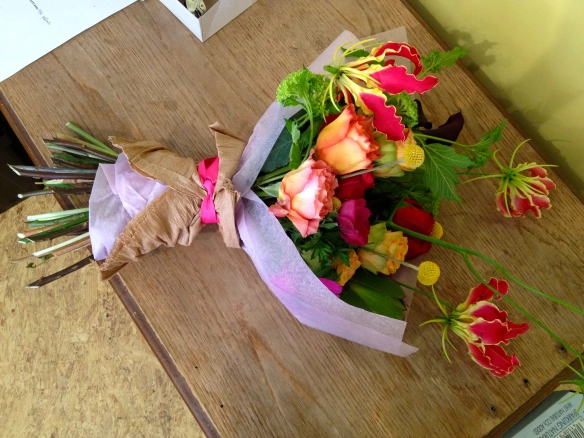I try to employ eco-friendly practices when creating floral designs. But what does that mean? You might think that the very act of arranging flowers would be considered “green,” or eco-friendly. But there are many elements of the floral industry to consider if you want to feel good about creating beauty with the treasures of nature you’re bringing into your home.
Today, we have an abundance of choice at our fingertips. From the tiniest of flowers like lily of the valley and delicate white stephanotis, to dinner plate-sized dahlias the color of sunsets, and huge garden roses that resemble peonies, the diversity and array in the floral kingdom are literally endless. Exotics and tropical flowers and foliage are readily available. We can get orchids, carnations, mums and lilies anytime of the year. The choices are downright dizzying.
You might pick up a store bought bouquet and have no idea where your flowers came from: in fact, 60% of the flowers sold in the U.S were actually grown outside of the U.S. Transporting flowers from Holland or Ecuador requires not only the jet fuel to travel, but also a great deal of packaging to protect your glorious buds and blooms.
On top of that, these flowers may have been grown in a country where regulations on the use of various pesticides are looser than ours in the U.S.; where workers are exposed to harmful chemicals, as are the many people who handle the flowers as they make their long journey from grower to auction house to wholesaler to retailer to you. Additionally, the flowers themselves may be out of season, difficult to grow, and require energy-draining practices to force them into bloom.
Don’t be dismayed, because they are many ways to avoid these imported, chemical-saturated blooms, and practice eco-friendly floral design. First, consider what’s in your yard or garden. If there’s not much there, and you have the space, start your own cutting garden. Seeds are cheap! Companies like Seedsavers in Decorah, Iowa, offer organic, non-GMO heirloom varieties of a great number of flowers great for home arranging. There are many seed companies with excellent cut flower choices for the home grower. This year I started a cutting garden and I plan to grow even more this year!
If you must purchase cut flowers, try to source them from local growers who practice sustainable growing methods. If you’re in the Philly area, check out Love n Fresh Flowers, run by Jennie Love. Also check out Kate Sparks of Lilies and Lavender. Local florists like falls flowers run green businesses, where they source as many locally grown flowers as possible, and recycle just about every scrap of anything used in the store. These are just a few of my eco heroes.
If you buy cut flowers from your local grocery store, inquire as to their origin, and seek out stores who sell sustainably grown cut flowers such as Whole Foods and Trader Joe’s. Additionally, try to buy cut flowers that are in season.
When arranging flowers, I try to avoid using floral foam – it’s not biodegradable and contains formaldehyde which can cause health issues over time. Instead, use fresh clean water and sustainable floral mechanics like branches to hold up your stems.
Other ‘green’ mechanics that can support floral materials include the use of sand, or fashioning a grid made from tape that’s affixed to the top of your container. I had fun cutting up lemons and using them in the design below – they not only provide a place for stems but also acts as a decorative element when viewed through glass containers.
There are many other floral design techniques which can be considered eco-friendly – such as using less material, a principle that is found throughout many schools of Ikebana. For example, it’s easy to create unique arrangements by grouping smaller vases together and only using one or two stems in each. Or, it can make quite a powerful design statement to see one or two bold sunflower stems in a clean glass vase.
And finally, when your flowers have faded, be sure to compost them!





























